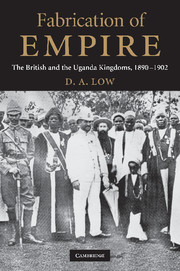Book contents
- Frontmatter
- Contents
- Preface
- List of abbreviations and locations
- Sketch maps
- 1 Prologue: survey and agenda
- 2 Statecraft: external intrusion and local dominion
- 3 Ferment: conversion and revolution in Buganda
- 4 Upcountry: might-have-beens and the Buganda/Uganda outcome
- 5 Warbands: new military formations and ground level imperialism
- 6 Paramountcy: Toro, Busoga and the new overlords
- 7 Defeat: Kabalega's resistance, Mwanga's revolt and the Sudanese mutiny
- 8 Succession: Nkore and the war of Igumira's eye
- 9 Dénouement: aggregations and rulerships
- 10 Government: colonial settlements and the Buganda model
- 11 Capstone: honour, awe and imperialism
- 12 Round up and review
- Select bibliography
- Index
10 - Government: colonial settlements and the Buganda model
Published online by Cambridge University Press: 04 July 2009
- Frontmatter
- Contents
- Preface
- List of abbreviations and locations
- Sketch maps
- 1 Prologue: survey and agenda
- 2 Statecraft: external intrusion and local dominion
- 3 Ferment: conversion and revolution in Buganda
- 4 Upcountry: might-have-beens and the Buganda/Uganda outcome
- 5 Warbands: new military formations and ground level imperialism
- 6 Paramountcy: Toro, Busoga and the new overlords
- 7 Defeat: Kabalega's resistance, Mwanga's revolt and the Sudanese mutiny
- 8 Succession: Nkore and the war of Igumira's eye
- 9 Dénouement: aggregations and rulerships
- 10 Government: colonial settlements and the Buganda model
- 11 Capstone: honour, awe and imperialism
- 12 Round up and review
- Select bibliography
- Index
Summary
By the late 1890s the ‘determining vortexes’ which had ensued upon the initial ‘raw assertions of British hegemony’ in the five component parts of the now emerging Uganda had largely reached their closure. All five now stood subject to British colonial authority. Under its aegis the Christian oligarchy was firmly in control in Buganda. Mwanga's revolt had petered out, and both Mwanga and Kintu were now languishing in exile. In Bunyoro, Kabalega lay in exile too, but, along with a miscellany of other chiefs, two of his principal Abarasura leaders, Rwabudongo and Byabachwezi, having submitted to the British, now held chiefly positions under them; while in Nkore, following the toppling of bot h Kahitsi and Igumira, Mbaguta stood forth as its principal chief. In each of these instances, the leading figures were ex-new model warband leaders. Kasagama meanwhile had successfully clamped his paramountcy upon his fellow Babito in Toro; while, following the departure of the Sudanese mutineers, Grant, as we shall see, had effectively reestablished his dominance over Busoga.
The principal issue for those primarily involved accordingly became (as the analysis earlier offered here was designed to anticipate) the shaping of the ‘colonial settlements’ that would constitute the governing structure of the new Uganda Protectorate.
- Type
- Chapter
- Information
- Fabrication of EmpireThe British and the Uganda Kingdoms, 1890–1902, pp. 281 - 317Publisher: Cambridge University PressPrint publication year: 2009



